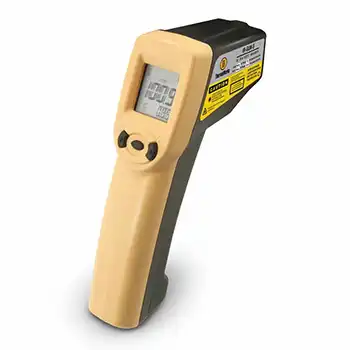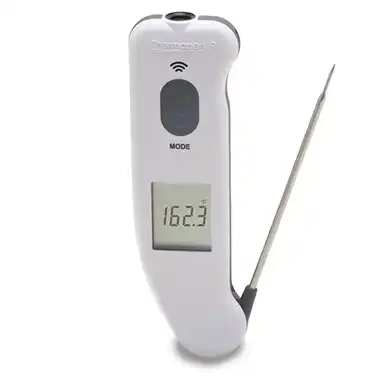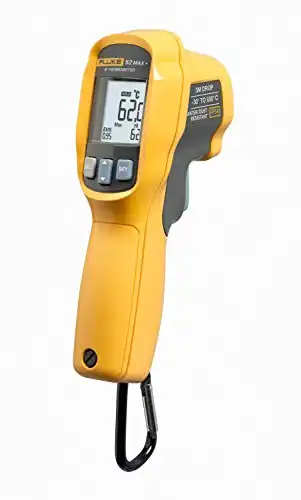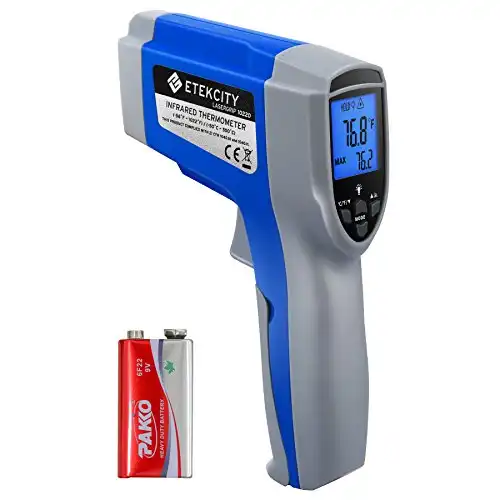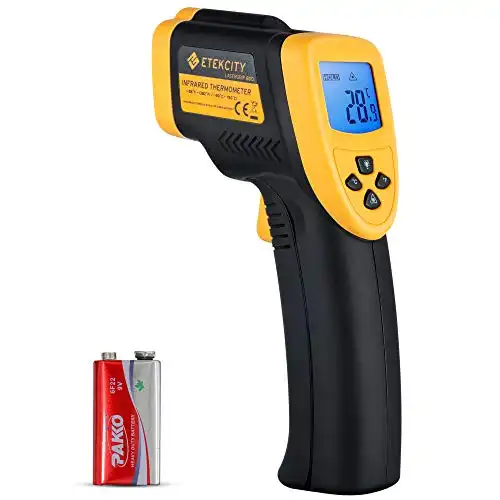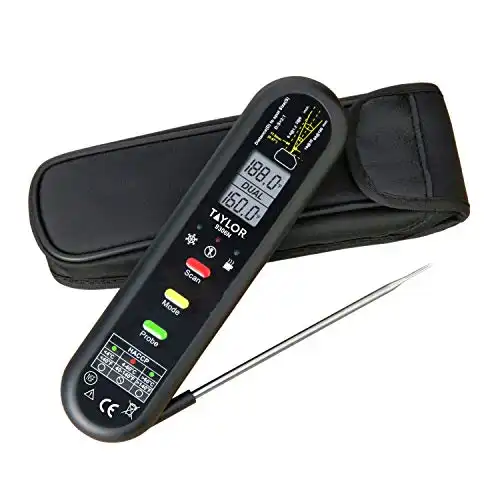The 6 Best Infrared Thermometers For Cooking in 2024

A good infrared thermometer will let you stand at a safe distance from the heat and still give you a quick and accurate read on the temperature of whatever you point it at, making it a massively useful addition to your arsenal.
To make sure you’re working with the best possible kit, we’ve put together an in-depth review of some of the best infrared thermometers available.
For measuring the temperature of your griddle, grill surface, or pizza oven we recommend the ThermoWorks Industrial Infrared Temperature Gun due to its build quality and accuracy.
Our Top 6 Picks for Best Infrared Thermometer in 2024
1. Best Overall – ThermoWorks Industrial Infrared Temperature Gun

The Thermoworks Industrial IR non contact temperature gun is our favorite gun style infrared thermometer with a great range of features, even if it is a little less robust than our overall winner.
With a 12:1 distance-to-target spot ratio, you’ll be able to get a 1-second read on the temperature of a 1-inch section of most surfaces from 12 inches away. You can expect that reading to be accurate as well, with the Industrial IR Gun range running from -76 to 1022°F and its accuracy giving you a less than 2% variability.
Adjustable emissivity settings mean that anodized aluminum, copper pans, and polished stainless steel won’t throw off your readings because of their low emissivity rating.
The Industrial IR temperature gun has an optional “hi-lo” alarm built-in, which means you can set an ideal reading range, and the thermometer will sound an alarm if it detects temperatures significantly above or below that level.
The LCD screen is large and easy to read.
This comes in very handy for a variety of reasons, such as checking your HVAC systems, your household insulations, and even the seal on your offset smoker.
What we like
- The adjustable emissivity – This is useful in kitchens with lot of stainless steel or adonized aluminum. Usually, these surfaces throw off a thermometer because of their low emissivity rating, but the Industrial IR Gun can be adjusted to overcome that drawback.
- The “hi-lo” alarm – great for looking for hotspots or busted seals in your smokers, pellet grills, or anything where keeping consistent temperature is essential. You don’t need to keep writing down and comparing numbers; you can just set a temperature range and listen for the alarm.
- Better battery power – Unlike the 62 MAX Plus, the Industrial IR Gun is powered by 2x AAA batteries, which gives it a longer battery life.
What we didn’t like
- It’s not particularly durable – The Industrial IR Gun doesn’t have the IP 54 rating or the 3-meter drop resistance of the 62 MAX Plus, making it a little more vulnerable to the standard variety of kitchen accidents.
2. Best for cooking – ThermoWorks Thermapen® IR

Why bother buying both an infrared thermometer and a probe thermometer when the Thermapen® IR bundles both in one compact package!
We were already big fans of the Thermapen, now with the addition of an IR scanner on the other end, the Thermapen® IR is a fantastic, versatile tool in any pitmaster’s armory.
You can check your grill plate is up to temperature, slap on your steaks, and use the same tool to make sure you’re taking them off the grill just before they hit perfect medium-rare.
The Thermapen® IR can be used both left and right-handed, and the backlit LCD display rotates, so you’ll always be able to see the readout. It comes with adjustable emissivity settings, from 0.1 to 1.0, so you’ll be able to adjust for any low-emissivity surfaces you might be using.
You can also expect a precise temperature reading, as the Thermapen® can give you a surface temperature to within ±0.7°F.
With a motion-sensitive sleep function, you can keep all your attention on your cooking while using the Thermapen®. It wakes up when you reach for it and powers down when you set it down again. It’s also IP 54 rated, so if you happen to set it down in some sauce, it’s not the end of the world.
The compact size and combination of probe and IR scanner make the Thermapen® the best possible thermometer for cooking.
What we like:
- The one-handed use – The combination of its compact size and its motion-sensitive sleep function means the Thermapen® IR is really easy to use one-handed. The backlit display wakes up when you pull it out of your pocket or apron and shuts down when you’re done with it. The rotating LCD display also means it doesn’t matter which hand you use it in.
- The convenience – The fact that the Thermapen® IR covers all your bases means you need less clutter in the kitchen and don’t need to be swapping between devices to get reliable temperature reads.
- The size – The Thermapen® is small enough to fit into one hand and is ergonomically designed to do just that, which makes it easy and convenient to both use and transport.
What we didn’t like:
- The price – Although it is undoubtedly worth the money you pay for it, the Thermapen® IR has a pretty hefty price tag, which means it might be outside of some pitmasters’ budgets.
- Limited range compared to a temperature gun – If you need to be able to take temperature measurements from a safe distance, the Thermapen isn’t the best option.
3. Also Great – Fluke 62 MAX Plus Non-contact Infrared Thermometer
The Fluke 62 MAX Plus non-contact is a good alternative to the ThermoWorks with a nice combination of durability and functionality.
One of the chief complaints about IR thermometers is that they can be quite fragile, but the Fluke 62 MAX Plus is more than capable of riding out the usual drops and bumps that kitchen equipment typically faces.
The robust plastic outer is IP 54 rated, which means it’s protected against dust and splashes of liquid, ideal for surviving the standard cookout.
It’s also drop-rated for 3 meters, so unless you’re using it on the roof, the occasional butterfingers moment isn’t going to result in a broken thermometer.
With a range of -22°F to 1202°F and an accuracy rating of ±1.0% of the reading, the Fluke 62 MAX Plus will give you precise read temperatures on the hottest grill from up to 12 meters away.
To make sure you are reading the temperature for the right surface, the Fluke 62 MAX Plus comes with dual laser sighting to keep you on target.
If you are firing up the pizza oven the combination of laser guidance and the backlit LCD screen means you won’t even need to leave your chair to check on the temperature.
What we like:
- It’s super durable – Fluke built the 62 MAX Plus to survive “the dirtiest and dustiest industrial sites,” so you can expect it to deal with most of the accidents that happen around the grill. Its IP 54 rating is more than enough to keep scattered dry rub and splashed beer out of its innards.
- It’s drop-proof (to an extent) – The occasional drop won’t phase the 62 MAX Plus, as long as its less than 3 meters. This means you can stop worrying about dropping your thermometer and get on with concentrating on your cooking.
- It’s very accurate – With a huge range – up to 1202°F – and only a 1% variation in temperature readings, the 62 MAX Plus is the best way to get a precice surface temperature reading. Not bad for something you can use up to 12 meters away from the object you are scanning!
- It’s laser-guided – Getting an exact reading of what you’re aiming at, and only what your aiming at, is much easier thanks to the 62 MAX Plus’ precise dual-lasers. If you are worried about anyone getting flashed in the eyes with the targeting laser, don’t worry, they can be turned off.
- The three-year warranty – Fluke is obviously happy to stand behind the quality of the 62 MAX Plus, which is why they offer a three-year warranty on all manufacturing faults.
What we didn’t like:
- The battery life – The 62 MAX Plus takes a single AA battery, which does mean it is compact and easy to store, but it does somewhat cut down its battery life. With only a single battery, you can expect your 62 MAX Plus to last just 8 hours with laser and backlight on.
- The manual – Unfortunately, the worst part of the 62 MAX Plus is the manual. Instead of written instructions for this well-made and sophisticated device, the manual is written in simple pictograms, like IKEA flat-pack instructions.
The combination of price and features make the Fluke 62 MAX one of our favorite laser thermometers.
4. Best Budget – Etekcity 1022D Dual Laser Digital Infrared Temperature Gun
For the price you pay for it, the Etekcity 1022D digital laser infrared thermometer comes with a fantastic amount of features.
The temperature range of 58°F to 1022°F and the distance to spot ratio of 12:1 with a response time of ≤500Ms are compatible with other, far more expensive models.
The temperature gun is chunkier than the other models on our list, and it lacks the protections and the drop resistance of the 62 MAX Plus. However, the large backlit LCD screen, dual laser targeting, and 9-volt battery power more than make up for that.
If any manufacturing issues do crop up with your 1022D, you are covered by the 2-year warranty from Etekcity
What we like:
- The price – Obviously, for our best budget pick, the cost of the Etekcity 1022D is one of the most critical factors. Still, the fact that you get features like dual laser targeting and adjustable emissivity for a price that is around ⅙ of the cost of other models is fantastic.
- The warranty – Generally, budget electronics do not come with a warranty, but the 1022D comes with a 2-year warranty against manufacturing faults from Etekcity.
- The battery life – The combination of that chunky 9-volt battery and an auto-off function means you won’t have to worry about your thermometer during the course of a cookout or competition.
What we didn’t like:
- The size – It’s only a mild complaint, but the Etekcity 1022D is a fair bit larger and chunkier than the other digital infrared thermometers on our list. If you’re space-conscious or looking to put together an on-the-road BBQ competition kit, you might want to invest in one of the more compact models.
5. Another great cheap option – Etekcity Lasergrip 800 Digital Laser Infrared Thermometer Gun
The Etekcity Lasergrip 800 temperature gun is an upgraded version of the incredibly popular Etek City Lasergrip 1080. It also shares a lot of the factors that made the Etekcity 1022D such a reasonable budget digital infrared thermometer option, but it lacks some of the extra functions of the 1022D.
It has laser guidance, but it’s only a single, not dual lasers. There’s also no adjustable emissivity setting.
The one thing the Lasergrip 800 does better than the 1022D is its longer 16: 1 distance to spot ratio.
So, if you’re looking for a low-cost infrared temperature gun that works well in the kitchen but also in longer-range industrial settings, keep the Etekcity Lasergrip 800 in mind.
What we like:
- Larger distance to spot ratio – The 16:1 ratio means you can get a more accurate measure on items at larger measurement area with the same distance.
- LCD screen – Contains all the info you need, including a handy low battery indicator so you won’t risk running out of battery at a bad time.
What we don’t like:
- Poorly designed battery compartment – No information on how to open it in the instructions and seems a bit tight to fit the battery and connector.
- Can only display four digits – Because it counts the decimal point as one digit, if you are measuring temperature over 1,000 degrees, the LCD screen cuts off the first digit.
Also worth considering
6. Taylor Precision Products Dual Temperature Infrared/Thermocouple Thermometer
The Taylor Precision Products splash-proof dual temperature infrared/thermocouple thermometer is about half the price of the Thermapen® IR and has many of the same functions.
It features a combination probe and infrared thermometer, adjustable emissivity settings, and an auto-shutoff.
However, the Taylor Precision Product lacks some of the Thermapen’s ease-of-use functions. It is not motion-sensitive and the digital display does not rotate, making it hard to use if you are left-handed.
Another potential issue is that the temp range only goes up to 482°F, which might not be high enough for some grilling setups.
Why buy an infrared thermometer?
The ability to get an instantaneous read on the heat of cooking food, surfaces and the temperature of equipment like grills or pizza ovens is a hugely important part of preparing your food exactly how you want it.
Getting a quick and exact read on the temperature of your grill, for instance, is by far the best way to make sure that your porterhouse steak hits the plate at 130°F, for that perfect medium-rare.
Infrared thermometers are quick, easy to use, and will give you a far more accurate temperature measurements than holding your hand over your grill.
You can use your infrared thermometer to check your grill plates have come up to temperature, make sure your fryer oil is up to 350°F, so your onion rings don’t get soggy.
When you’re not using it in the kitchen, you’ll find your infrared thermometer is surprisingly useful around the house.
You can use it to identify poorly insulated areas of your loft, diagnose issues with you heating, ventilation, and air conditioning (HVAC) systems, and check that that steel slide that’s been sitting in the sun all day isn’t going to burn anyone’s back.
How does an infrared thermometer work?
In simple terms, the hotter an object is, the more infrared energy it releases.
Your thermometer picks up that infrared radiation converts it into electricity, and uses the amount of electricity being produced to determine exactly how hot it is.
Infrared radiation is what we refer to as heat and is one of many forms of radiation on the electromagnetic spectrum. To measure the amount of radiation being given off by a specific object, a handheld infrared thermometer focusses it through a lens, in a manner similar to light.
The lens focuses the radiation being emitted by the object onto a detector called a thermopile, which converts it into electricity. That electricity is then sent on to another sensor, which measures the amount of electricity being produced and turns it into a readable temperature.
How to use an infrared thermometer
One of the benefits of infrared thermometers is just how easy they are to use.
For most temperature gun models, all you’ll need to do is point your thermometer at whatever you want to measure the temperature of, pull the trigger, and read the display.
Compared to other thermometers, this can be done at range, which is ideal for situations where you don’t want to get your hands close to the heat.
There are, however, a few things to take into consideration when using an infrared thermometer to help you get the most accurate readings.
The distance to target ratio
The distance to target ratio of your infrared thermometer is an indication of how large a circle of surface area the thermometer will read at a specific range. For instance, if your thermometer has a 12:1 ratio, it will measure the temperature of a 1-inch diameter circle of whatever you are pointing it at from 12 inches away.
This is an important ratio to keep in mind, so you have a clear idea of how far away from an object you have to hold your infrared thermometer to measure the temperature and not the temperature of the surface around it.
Your infrared thermometer can’t measure everything
As great as they are, your infrared thermometer can’t see through glass, clear plastic, or water. If you are pointing your thermometer out the window, you just measure the surface temperature of the glass.
Infrared thermometers can also have trouble getting accurate readings from highly-polished metals because they tend to reflect ambient infrared energy more effectively than they emit their own radiation.
What features to consider when buying an IR Thermometer
Temperature range
When selecting a thermometer, the first thing you’ll need to take into account is the temperature measuring range of the model you are considering purchasing.
IR thermometers that are not designed for HVAC or kitchen use can sometimes have a low upper-temperature limit, meaning they won’t be any good for measuring if your grill has gotten up to temperature.
Accuracy
Accuracy is also an essential factor in choosing an infrared thermometer. If you are using your infrared thermometer to check if your reheated food has reached 165°F and is safe to eat, then you’ll want the temperature measurement it takes to be as precise as possible.
Intended use case
Not all thermometer guns are built with the same use case in mind. We have focused our attention on thermometers that take the surface temperature of household objects like your grill or pizza oven.
If you want an thermometer for taking body temperature for medical purposes you should look for a thermometer for that special purpose like the iHealth Infrared Forehead Thermometer. This uses infrared technology to measure body temperature safetly.
Emissivity
Emissivity is a reference to the efficiency with which a surface emits thermal energy.
Different surfaces have different levels. As we mentioned earlier, infrared thermometers can have trouble getting an accurate reading from certain materials, such as highly polished stainless steel.
To compensate for this, some models of infrared thermometers have a variable emissivity setting. If you are cooking with a lot of materials with low emissivity ratings, such as anodized aluminum or copper, its best to invest in an infrared thermometer with changeable setting.
Optics
The optics for infrared thermometers come in one of three types: no lens, fresnel lens, and mica lens. Each has its own advantages and disadvantages, and the lens type you choose can have a significant effect on how well your thermometer performs in certain conditions.
1. No lens
A no-lens thermometer doesn’t use a lens to focus the infrared radiation onto its sensors. Because of this, they are more robust, less expensive, and smaller than other types of infrared thermometers.
They do, however, have the considerable drawback of having a distance to target ratio of 1:1 or lower. This means you’ll have to get your no-lens thermometer as close to the surface you are scanning to get an accurate reading. Not ideal when you’re trying to measure the temperature of a screaming hot grill.
This lack of ability to get a temperature reading at range makes a no-lens thermometer far less useful to a pitmaster than ones with a fresnel or mica lens.
2. Fresnel lens
Fresnel lens thermometers use a plastic lens that is more durable than a mica lens but has a narrower temperature range.
If you are buying a fresnel lens thermometer, always check that its range exceeds the maximum temperature you might want to bring your grill up to, so you can get an accurate reading of how hot your grill plates are.
Fresnel lens thermometers tend to be the best optics choice for kitchen cooking use as, unlike a no-lens thermometer, they can be used at range, and they are durable enough to take a few knocks without breaking.
3. Mica lens
Mica lens thermometers are the most accurate, have the highest temperature range, and can produce the most accurate readings at a distance with their 20:1 distance to target ratios.
They are, however, expensive and far more fragile than a fresnel lens. As a general rule, the fact that your mica lens infrared thermometer can measure temperatures above 1,000°C from 20 feet away isn’t going to come up that often at a cookout, so it’s probably best to stick with the more durable fresnel lens.
Misconceptions About Infrared Thermometers
- They use a laser to measure temperature – The laser you see being emitted by your thermometer is just a guide. The thermopile inside the device is doing the actual temperature measuring.
- They can measure internal food temperatures – Unfortunately, this isn’t true. An infrared thermometer only reads the surface temperature of whatever material you are pointing it at. They work very well for telling the temperature of cooking surfaces and liquids, but you’ll need a probe thermometer if you want to know the internal temperature of meat, for example. This is why we like the Thermapen IR because it gives you the option to measure internal food temperatures with a probe as well as infrared temperature.
- They can read temperatures on any surface – As we mentioned earlier, lasor thermometers struggle with surfaces that have a low emissivity rating, like aluminum or polished steel.
If you cook with these materials a lot, get yourself an infrared thermometer with a variable emissivity setting, which will help you get a more accurate read of highly reflective surfaces.
How to get the most of out your infrared thermometer in the kitchen
Just because infrared thermometers only measure surface temperature, doesn’t mean they aren’t super handy in the kitchen.
Here a few ways to use your thermometer in the kitchen:
- Measure the temperature of cooking oil
- Measure temperature of liquids you don’t want to get too hot like milk and melted butter
- Checking the temperature of a pizza stone or barbecue grates
- Checking the temperature of a hot pan
How do I calibrate an infrared thermometer?
Calibrating an laser thermometer is a complex process that often needs to be done by the device’s manufacturer, but you can check if your thermometer is calibrated correctly at home.
The easiest way to check if your infrared thermometer is correctly calibrated is by using the “ice bath” method. Just follow the steps below:
- Fill a large glass container to the very top with crushed ice.
- Then fill the glass with chilled water until the water level sits about 1-centimeter below the top of the crushed ice.
- Stir the water and ice mixture and let it sit for around 2 minutes.
- If it has a variable emissivity option, set your infrared thermometer to an emissivity setting of 0.95 or 0.97.
- Hold your thermometer exactly above and perpendicular to the surface of the ice bath and make sure the ice is well within the laser circle and the thermometer’s minimum distance to target ratio.
- If your thermometer is properly calibrated, it should read the temperature of the water as 32.0°F. If this isn’t the case, repeat the test. If it’s still not reading as 32.0°F, contact your device’s manufacturer.
How accurate are infrared thermometers?
As a rule, infrared thermometers are more accurate than surface probe thermometers as the inherent temperature of the probe can affect the reading you get when it comes into contact with the object being measured.
However, it should be noted that the following things can affect the accuracy of the reading you get from your thermometer:
- Frost, moisture, dust, fog, smoke or other particles in the air.
- Rapid changes in ambient temperatures, such as entering a walk-in freezer.
- An inability to “see” through transparent surfaces, such as glass and certain liquids.
Can you check food’s internal temperature for doneness with an infrared thermometer?
Unfortunately not. As we’ve already mentioned, infrared thermometers only track the surface temperature of the object they are pointed at.

If you want to know something’s internal temperature, like that of a piece of meat, you’ll need a probe thermometer.
This is why the ThermoWorks Thermapen® IR is such a handy device to own.
Are infrared thermometers safe?
The only real safety concern for an infrared thermometer is the laser it emits to show you what you are pointing it at.
As long as you avoid shining that laser directly into someone’s eyes, you should be fine.
Wrapping it up
So there you have it! Infrared thermometers, especially ones that combine an infrared thermometer with a probe, are an excellent addition to your pitmaster’s toolset.
They let you have ultimate control over the temperature of your cooking surfaces and, with the Thermapen® IR, the food itself and good temperature control is the key to great cooking.
Are there any infrared thermometers that you think should have made our list? Do you think the use of an infrared thermometer has improved your cooking? We’d love it if you’d let us know in the comments below!

